


Individual abilities that form the human capital stock are defined in various ways. Within the school system, individual abilities are measured by the performance of an individual in an official test. Government and school authorities are constantly attempting to improve the capabilities of students and in turn produce highly qualified human capital that can drive economic growth. The education system is thus established with consideration of the factors that influence student performance.
Empirical studies have developed an education system model, in which authorities can adjust various factors to improve the capability of students. The suggested factors include expenditure per student, class size, pupil-teacher ratio, financial support from the government, and school autonomy on various decisions. Existing studies have analyzed the relationship between the education system and student performance using innerschool factors, such as those mentioned above (Hoxby 2000; Hanushek
The current study starts by exploring the notion that the education system depends not only school factors but also on social norms that rule the overall economy and politics in societies. Government and education authorities have developed an education blueprint to produce the desired human capital by implementing appropriate education policies and manipulating the school system. In particular, school autonomy has a direct correlation with the actions of the government. Therefore, the effects of these factors on student performance vary depending on the nature of the institution. If an education administration is open and decentralized, then various groups become involved in planning the education policy. In such a case, the effects of uniform education instructions from the government cannot be maximized as intended. Meanwhile, school autonomy in centralized societies cannot effectively improve student performance.
On the basis of this idea, this study introduces the quality of institutions into the general education production function employed in the work of Hanushek
School autonomy over academic, budget, and teacher-hiring issues are all important, as cited in the studies of Wößmann (2003) and Hanushek (2013). However, the present study finds that autonomy over budget plays an important role in student achievements when institutional variables are controlled. Moreover, a different education policy is suggested based on the level of students, that is, academic autonomy works remarkably well for those who belong to lower percentile groups while budget autonomy improves high-ranking groups.
The next section presents a review of previous literature. Section III discusses the underlying conceptual framework and develops an empirical model. Section IV describes the dataset used in this study. Section V presents the estimation and additional test results. Section VI provides the conclusions for this study.
The education performance of students reflects education quality. This topic has been extensively studied, and the findings of these studies have examined the factors that affect the education system as reflected in their output, which is the quality of students. Previous empirical works have constructed an education production function. Generally utilized forms include family background as an explanatory variable.
Hanushek (1992) states that the annual achievement growth of each student declines when they have more siblings. The work behavior of mothers has no apparent effect on the achievement of their children, and the income level of parents does not significantly affect the performance of their children. Wößmann (2005) shows that the education level of parents is positively related to the achievement of their children. In addition, the influence of family background on student performance is more evident in East Asia than in Western countries, such as the United States and those in the European region.
Several studies have focused on school resources as the main determinants of student performance. One of the frequently adopted variables is class size. Hoxby (2000) utilizes the two-stage least squares method to adjust the biased results of the existing education production function because of the unobserved parental characteristics when school resources are analyzed. The adjusted result still implies that class size is negatively related to student performance. Card and Krueger (1996) investigates the influence of school resources on education quality by comparing two states, namely, North Carolina and South Carolina. The result suggests that a wide gap in the pupil-teacher ratios of the groups leads to a wide gap in education level. A low pupil-teacher ratio positively affects student performance.
Morgan and Sirageldin (1968), Johnson and Stafford (1973), Wachtel (1976), and Rizzuto and Wachtel (1980) use total expenditures per student as an index of education quality. However, Card and Krueger (1992) posits that teacher salaries and pupil-teacher ratio should both be considered because a large amount of education expenditures are spent on salaries; the amount of salaries per teacher is related to pupil-teacher ratios.
An increasing number of studies have highlighted school-level institutions that influence student performance. Moreover, the literature indicates that not all institutions contribute positive effects. Hoxby (1996) explains that teachers’ unions increase school input, such as teacher salaries and books, by raising school budgets. However, productivity is decreased, causing a negative effect on student performance. Rouse (1998) reports that parental choice affects the changes in score gains. Students in the Parental Choice Program, which enables parents to choose to send their children to either private schools or public schools, have faster score gains in mathematics than other students do. Han
In contrast to the aforementioned studies, Woßmann (2003) adds school responsibilities on formulating the school budget, purchasing supplies, hiring teachers, and determining teacher salaries as institutional variables. Regression results indicate that school autonomy on process and personnel decisions is positively related to student performance. Conversely, school autonomy on standard settings and performance control has adverse effects on student performance (Bishop and Woßmann 2004).
Clark (2009) considers the relationship between school autonomy and the state government. When schools in the UK were converted to grantmaintained schools, they became funded by the central government and were given power over admissions and other operations. However, the school boards were required to follow instructions provided by the state government. In other words, acquiring school autonomy and financial support is accompanied by instructions from the government (Richards 1992). Therefore, the government becomes an important issue as well because its quality and blueprints affect the education policies that it implements. Hanushek
Using empirical methods, the current study presents the influence of the interaction between school autonomy and the quality of the government on the quality of the education system. The education production function is defined by adding the indicators of the quality of the government with additional explanatory variables for controlling country-level indices. By adding interaction terms between school autonomy and institutional quality, this study can investigate the effects of these variables on student performance.
Various empirical models have been proposed to determine the kinds of factors that affect the quality of the education system as measured by the test scores of students. The education production function approach has been applied to empirical models and has been extended to a wide range of empirical studies. A typical education production function represents student outcomes (
Hanushek (1992) formulates the function by considering family size and structure, the presence of a father, and the time that parents spend with the students as family inputs and the interactions of teachers with students as school input. Hanushek (2003) extends his study by obtaining the pupil-teacher ratio, the academic background and experience of teachers, and the school budget on education as school inputs. In the study of Woßmann (2003), school factors include additional variables, such as shortage of materials and instruction time. The empirical strategy of Woßmann (2003) differs from those of previous studies because it involves examining the effects of the school system (Inst) on education production:
Hanushek (2013) follows the concepts by focusing on the role of school autonomy among the school system variables used by Woßmann (2003). The former analyzes the effects of the local capacity of deciding academic content, budget formulation, and personal management on the achievement of students.
In the current study, the author introduces additional ideas by emphasizing that the quality of the education system is affected by countrylevel institutional factors and that the school system represented by autonomy interacts with these factors as mentioned in the previous section. In this study, school autonomy is reclassified as a school factor, which has been assumed to be an institutional factor in previous studies. Meanwhile, country-level institutional factors replace the variable “Inst” in Equation (2).
To test the influence of institutions on the quality of education and its interaction with the school system, the author considers the education production function framework described previously and employs a fixed effect estimation. A linear formulation is introduced as follows:
where
Equation (3) only investigates the direct effects of institutions on the quality of education. Therefore, an interaction term between the quality of government institutions and school autonomy is added in the following:
where
The direct and indirect effects of school autonomy on the quality of education are examined in this model. The interaction terms are generated for each institutional factor. Through them, analysis can be conducted to determine the extent to which school autonomy indirectly affects the quality of education through institutions.
The main dataset used in this study is dependent on the Program for International Student Assessment (PISA), which is an internationally standardized assessment conducted by the Organization for Economic Cooperation and Development (OECD). Targeting 15-year-old students in each country, the PISA examines a range of relevant skills and competencies. The subjects included in the test are mathematics, science, and reading.1 Variables from the results in 2000, 2003, 2006, 2009, and 2012 are merged into one dataset. As the achievements of international students are only available from the PISA,2 the sample countries are limited to those that participated in the assessments. Furthermore, the waves of analyzed dataset are limited to the periods in which the PISA test was conducted.
In the current work, the dependent variable is measured by the test scores in mathematics, science, and reading. The weighted mean of the scores in these subjects was used, assigning the largest weighted value to mathematics and the smallest weighted value to reading. Other additional surveys are conducted to collect background information on each student and school. Questionnaires are distributed to teachers to mea-sure several school factors.
School autonomy is a key variable to be examined because it plays an important role in the school system and affects the education system through country-level institutions. School autonomy refers to the degree to which agents belonging to each school depend on the local or state government in the decision-making process related to school operations. Two decision-making types are used. First, school autonomy over academic decisions is asked in the questionnaire through the following questions: “In your school, who has the main responsibility for which textbooks are used?” and “In your school, who has the main responsibility for determining course content?” Second, school autonomy over budget allocation depends on the following questions: “In your school, who has the main responsibility for formulating the school budget?” and “In your school, who has the main responsibility for deciding the budget allocations within the school?” Five checkboxes are labeled as follows: not a school responsibility, appointed or elected board member, principal, department head, and teachers. Except for the checkbox for “not a school responsibility,” the other checkboxes correspond to the decision-making agents who belong to the school system. To measure each type of school autonomy, the sum of the responses of each checkbox is normalized between 0 and 100. The normalized value of the “not a school responsibility” response is subtracted from the total responses to leave the true value that represents school autonomy. Whether the school has any influence on the decision-making process determines the autonomy over academic decisions and budget allocation decisions (Hanushek
Pupil-teacher ratio is obtained from the UNESCO dataset. The availability of mathematics teachers is obtained from the additional PISA surveys. The variable is measured using the question, “In your school, is the learning of <15-year-old students> hindered by a shortage of teachers?”
The operational indicator of democracy, which comes from Polity IV, is derived from the competitiveness of political participation, the openness and competitiveness of the executive, and the constraints on the chief executive. Governance effectiveness and control of corruption are obtained from the governance indicator provided by the World Bank. Governance effectiveness reflects the perceptions on the quality of public and civil services, the degree of its independence from political pres-sures, and the quality of policy formulation. Control of corruption reflects the perceptions on the extent to which public power is exercised for private gain, including both petty and grand forms of corruption, as well as the perceptions on the rule of the state by elites and private interests.
Table 1 summarizes the descriptive statistics of the variables used in the empirical model and its source. In terms of
[TABLE 1] DESCRIPTIVE STATISTICS
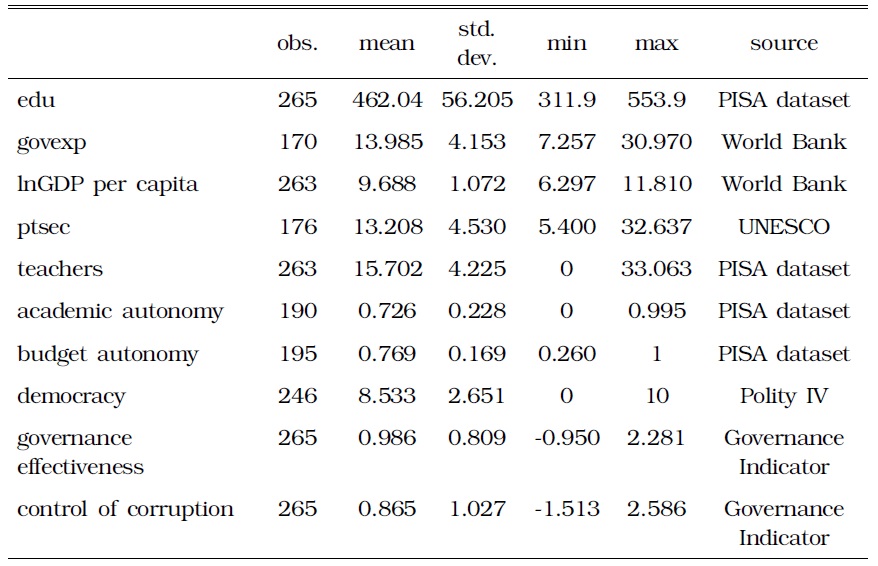
DESCRIPTIVE STATISTICS
The sample size of the analysis ranges from 170 to 265. If all the variables are extracted from the PISA dataset, then the full dataset with 265 observations can be used in the estimations. However, the ratio of government expenditure on education with 170 observations and the pupil-teacher ratio with 176 observations seem to deplete the observations of estimations. These variables come from different sources (
[TABLE 2] CORRELATION BETWEEN EXPLANATORY VARIABLES
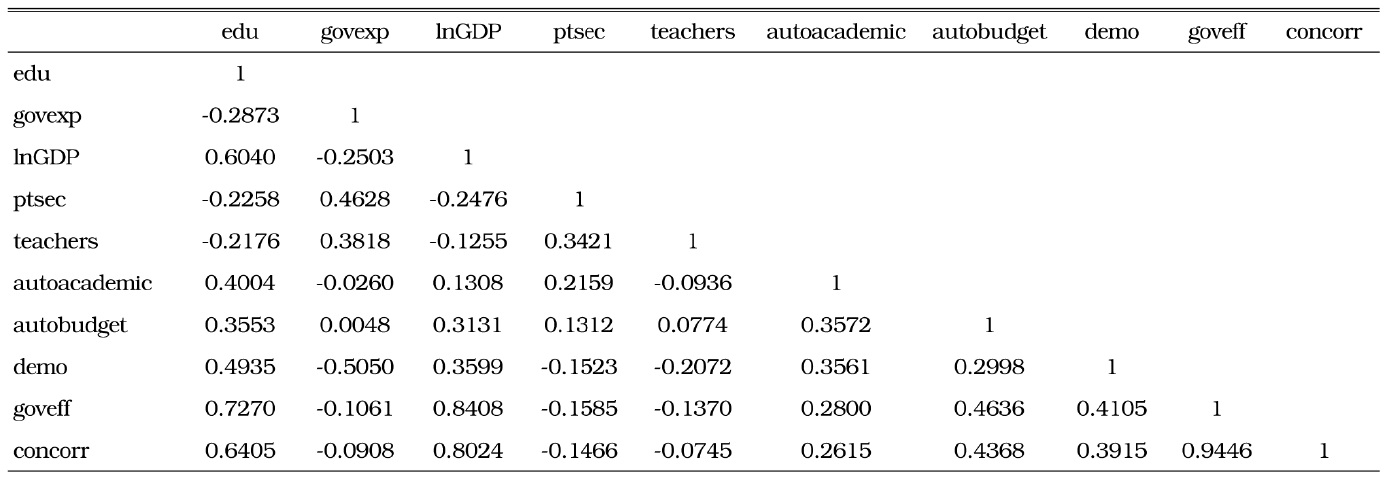
CORRELATION BETWEEN EXPLANATORY VARIABLES
1Four assessments were conducted in the following years: 2000, 2003, 2006, and 2009. A total of 27 OECD countries and 16 non-OECD countries participated in the assessment in 2000. In 2003, 30 OECD countries and 10 non-OECD countries participated. A total of 30 OECD countries and 27 non-OECD countries implemented the project in 2006. In 2009, 74 economies, including 34 OECD countries, implemented the program. The latest assessment in 2012 involved more emerging economies and few OECD countries. However, the results of this assessment were excluded in the study because the dataset only became available in December 2013. 2The PISA test is the only standardized test that compares the performance of students from several countries.
First, the empirical model of the general education production function from Equation (1) in Section III is estimated to determine how fundamental factors affect student achievement. Column (1) in Table 3 shows the results of the fixed effects. In general, the logarithm of the GDP per capita is positively significant, that is, students from rich countries generally achieve high performance. The ratio of government expenditure on education is insignificant. The availability of teachers has a positive trend but is not significant. However, the pupil-teacher ratio is significant with negative signs, which indicate that students from a small class size can be educated effectively and efficiently. Autonomy over academic decisions is negatively significant as well. The PISA is an internationally standardized assessment; thus, great power is given to the government to decide on the content and the textbooks to be used in schools. This condition leads to students achieving high scores. Therefore, the negative sign of school autonomy over academic decisions is sensible. However, autonomy over budget-related decisions is not significant, although it is negative as well.
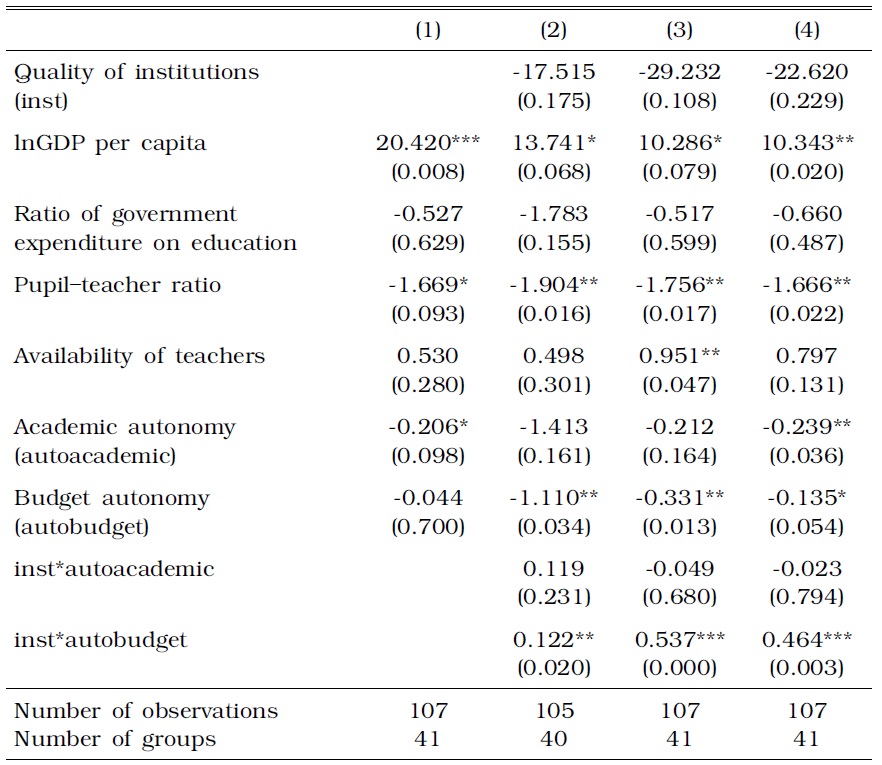
RESULTS OF THE PANEL FIXED EFFECTS ON THE INFLUENCE OF INSTITUTIONS AND SCHOOL AUTONOMY ON STUDENT PERFORMANCE
To analyze the effects of the quality of institutions and its interaction with school autonomy, institutional variables and their interaction terms with school autonomy are added in the remaining estimations. As proxies for the quality of institutions, democracy is used in column (2), governance effectiveness in column (3), and control of corruption in column (4). As shown in all three estimations, the quality of institutions does not have a direct effect on student performance. By contrast, GDP per capita and pupil-teacher ratio are statistically significant. The availability of teachers is significant when governance effectiveness is introduced. However, its effect is not guaranteed because it is insignificant with regard to the other institutional variables, namely, democracy and control of corruption. Different from that in column (1), the role of academic autonomy is ambiguous because it is significant only when control of corruption is used as a proxy for the quality of institutions. The change in the effects of budget autonomy after the addition of institutional variables is remarkable. As in column (1), it has no role when estimated in a typical education function, but it affects the education system, with country-level institutions additionally being controlled at any case in which proxies are used. It is significant and negative. The low level of budget autonomy indicates that external agents, such as the local or central governments, are in charge of securing the education budget and allocation to schools. Schools have difficulty in employing education and administrative processes autonomously. The result indicating that budget autonomy itself is negatively significant infers that schools with decision-making power over budget-related problems equates to a decreased student performance. Thus, the budget allocated by external agents works effectively and efficiently for schools when used to improve student abilities.
Interaction terms between the quality of institutions and school autonomy variables are also introduced. These terms are the most important because their significance supports the hypothesis of this study, which expects that education policies work indirectly through institutions and directly through student achievements. Looking into the first interaction term, academic autonomy does not seem to work on the education system. Although academic autonomy itself is significant in several estimations, academic autonomy is determined to have no role when it interacts with country-level institutions. However, when budget autonomy interacts with the quality of institutions, the result provides the opposite inference. The interaction term between the quality of institutions and budget autonomy is significantly positive. As the quality of institutions increases, the achievement of students improves if school boards are granted great autonomy over budget formulation and allocation. In the case of democracy denoting the quality of institutions in column (2), the explanations are as follows. A democratic society pursues a decentralized decisionmaking process and strengthens the autonomy of a school; their interaction positively affects student performance. Hence, democracy becomes a channel for budget autonomy to affect the education system positively. In column (3), the interaction between governance effectiveness and school autonomy over budget formulation and allocation decisions is significantly positive. This result indicates that autonomy over budget allocation works through government effectiveness to affect the education system positively. If the quality of public services improves and the education system becomes increasingly independent from the government, then school autonomy over budget-related decisions creates a positive synergy effect on education. Academic autonomy has no influence when it interacts with governance effectiveness. In addition, the estimation in column (4) infers that control of corruption is also a channel for school autonomy over budget-related decisions. As the capacity to monitor corrupt activities advances, the education system is effectively improved when the government hands over the authority to deal with budget-related issues to schools. Compared with external agents such as governments, school boards are more aware of the need for budget support to improve the school system. If corruption is eradicated effectively, then finances could be maximized through proper allocation instead of allotting them to unnecessary political activities.
The aforementioned results provide general implications that can be applied to the average education policies aimed at students. However, in practice, the several ways to raise student performance prove that the quality of the education system is good enough to produce a highly qualified labor force. One of these ways is to concentrate on the topranking students and assign them to comprise an elite group. Conversely, policymakers can focus on students who score in the middle or bottom percentile to raise the overall average scores. With this idea, the author conducts additional tests to determine whether the effects of institutions and the school system on student performance differ depending on the percentile groups of the scores of students. The PISA dataset provides the average scores at the 5
Table 4 shows how the quality of institutions and school autonomy influence the performance of low-ranking students at the 5
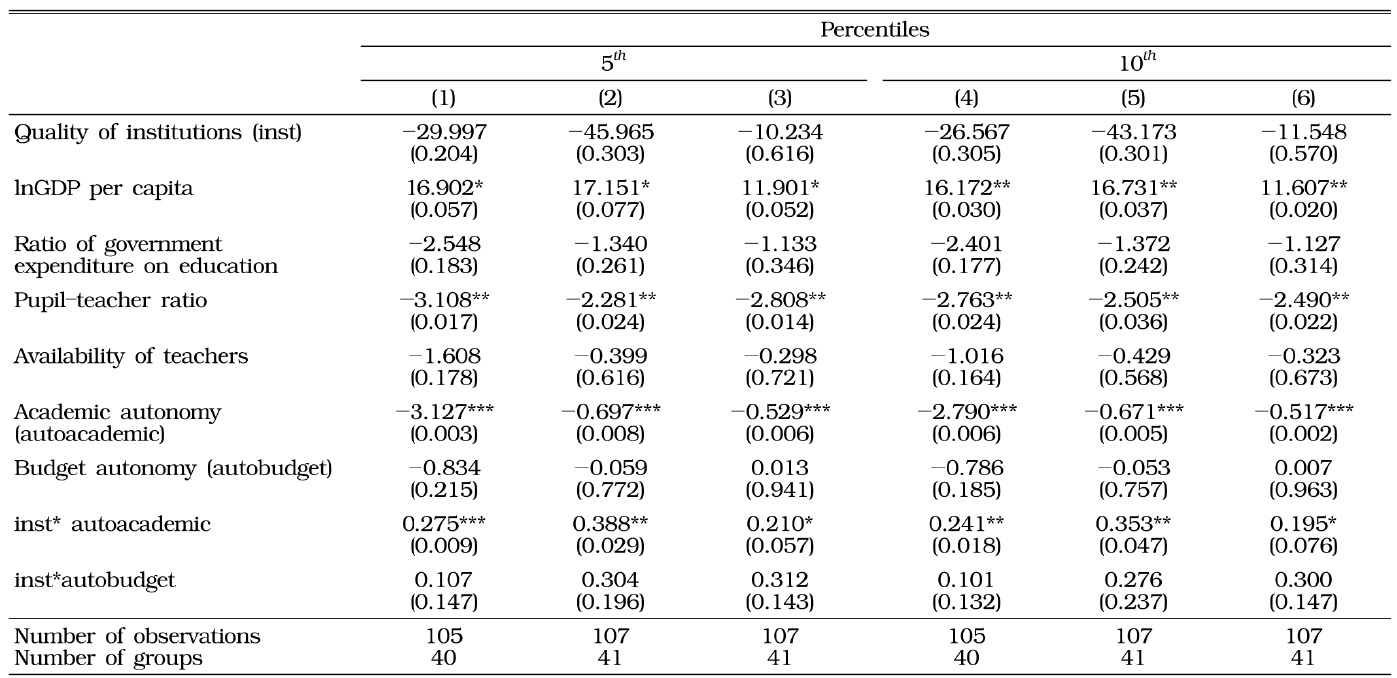
RESULTS OF THE PANEL FIXED EFFECTS ON THE INFLUENCE OF INSTITUTIONS AND SCHOOL AUTONOMY ON THE ACHIEVEMENT OF LOW-RANKING STUDENTS
Table 5 demonstrates the results of the panel fixed effects on the influence of institutions and school autonomy on high-ranking students. In the case of students in the 90
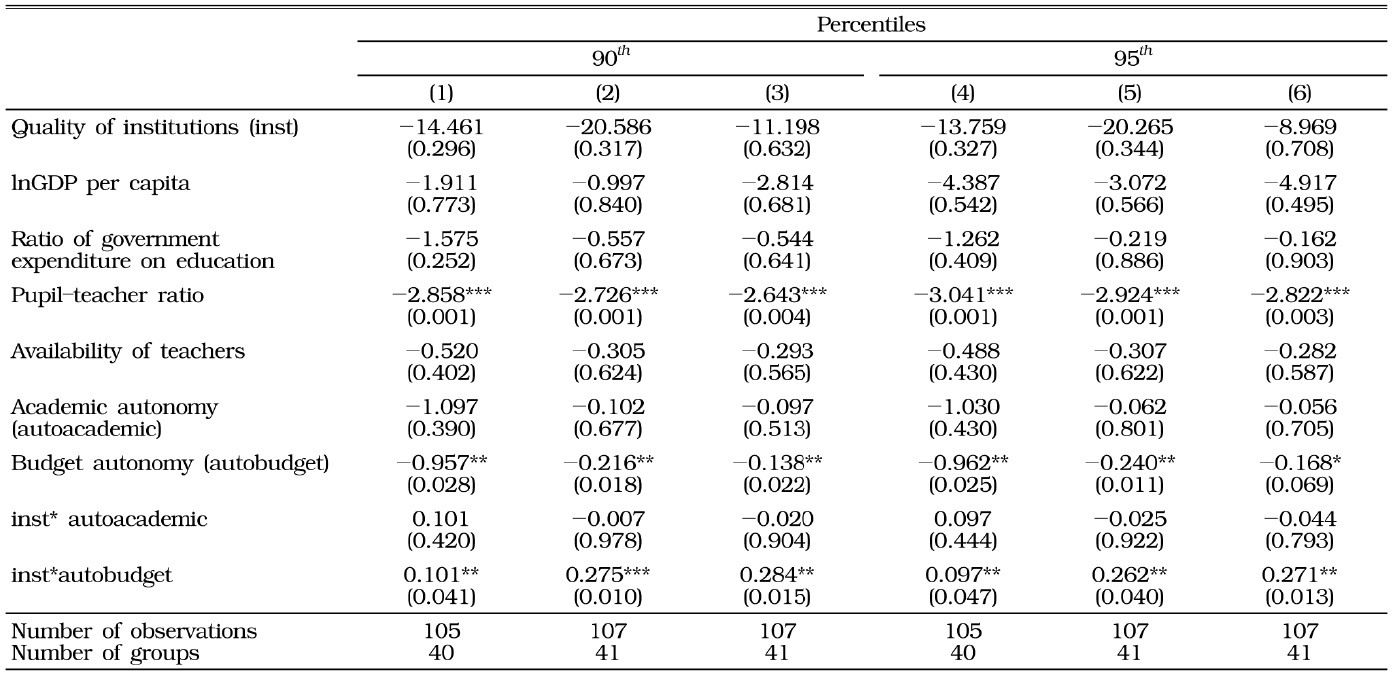
RESULTS OF THE PANEL FIXED EFFECTS ON THE INFLUENCE OF INSTITUTIONS AND SCHOOL AUTONOMY ON THE ACHIEVEMENT OF HIGH-RANKING STUDENTS
In an endogenous growth model, the ideas and inventions created by human capital stock through activities, such as research and development, are the driving forces of economic growth (Romer 1990). To increase growth rate, the government must foster the human capital that positively affects the economy. The government formulates policies and implements instructions to achieve its purpose of accumulating human capital stock. However, such goal can bring considerable burden to schools, which become executive organs. Thus, the quality of a school system differs in terms of the quality of country-level institutions and the pursuits of the government.
This study suggests that different education policies can be implemented depending on the level of institutional quality in society and the level of student abilities. On average, allowing the government to have the power to decide on budget formulation and usage positively influences student performance regardless of the institution level. In the case of academic problems, academic autonomy itself does not seem to directly affect student performance. The effects of the two types of autonomy are similar, considering their interactions with the quality of institutions. As the levels of democracy, effective governance, and corruption control of societies increase, allowing schools instead of the government to have the autonomy to formulate the school budget and decide on its usage highly benefits student performance. By contrast, academic autonomy does not directly influence education through institutions.
For each percentile group, different approaches to education policy are suggested based on the percentile level that the students belong to. A school with little autonomy over academic decisions benefits low-ranking students. However, if country-level institutions are considered and their quality improves, then providing schools with great autonomy over decisions related to academic courses and content is better than receiving academic instructions from the government. In the case of high-ranking students, their performance is effectively influenced by a small degree of budget autonomy. However, if the quality of institutions and public awareness improve, then providing the school board with autonomy over budget formulation and usage instead of over academic decisions is considerably effective.
Although this study has meaningful implications, it has a number of limitations. First, the analysis contains endogeneity because of sample selection bias. Most of the countries included in the dataset are OECD countries. OECD countries tend to have the highest levels of democracy, which are close to 10. Although Table 2 shows that the correlation between democracy and student performance is 0.4935, which is not as high as the other correlation values, the small sample size and the small variation within the democracy levels across the included countries make it difficult to prove that the analysis does not pose an endogenous problem.
Second, indices from the PISA dataset, such as test scores, the proportion of school budget from the government, academic autonomy, and budget autonomy, are obtained from the simple averages of each country. However, the education policies implemented by a state or a local government can vary in different localities, even those in the same country. Each proxy for the school factors from the PISA dataset does not capture the specific local differences of education systems.
Nonetheless, the PISA questionnaire can be improved by including more detailed information. This addition of considerably accurate and specified information can lead to highly reliable results. Furthermore, additional studies can be conducted based on the different results on the level of institutions and the percentile groups of student performance. The idea can be extended to consider country-level development stages. The quality of governments and institutions, as well as their effects, varies across different developmental stages. The general criterion that divides these stages is the GDP per capita. Through further research on the subject, appropriate education policies for developing, middleincome, and developed countries could be suggested to develop good labor forces that can drive economic growth.








